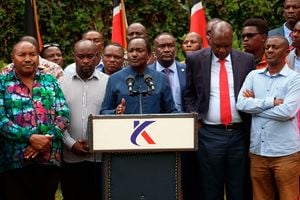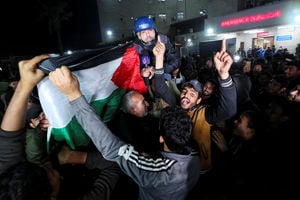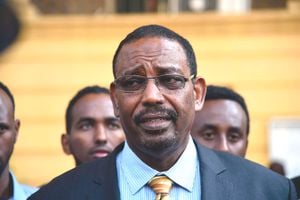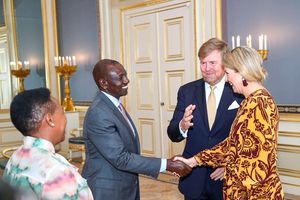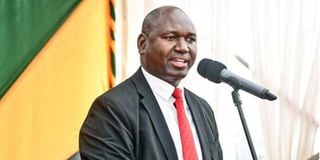
Kenya has agreed to elevate the status of more than 700,000 refugees in a move that could allow them free movement and eligibility to get jobs locally.
The four-year programme is expected to begin in November when refugees will begin receiving special identification cards. This will end the use of refugee cards and restrictions in camps.
The first phase of the programme could cost up to $943 million (Sh115.6 billion), money that is not yet readily available.
But Immigration Principal Secretary (PS) Julius Bitok told an audience in Turkana County on Thursday that they are fundraising from donors and the government will chip in to ensure it sticks to the timelines.
“This money will come from various partners and donors, including governments and the private sector. It will be channelled not only through the government but also through international NGOs, county governments and ministries,” he said.
The programme known as the Shirika Plan is not new, it has been delayed for the last two years due to funding constraints.
Kenya first agreed to turn Dadaab and Kakuma refugee camps, in Garissa and Turkana counties, respectively, in 2022 into formal urban centres to win over critics of its controversial decade-long bid to shut down the camps it said bred insecurity.
The government required money, and it reached out to donors and financial institutions including the World Bank.
The World Bank, the major funder of the programme, has since tied refugee welfare to financial support of Kenya’s programmes. Last month, when it agreed to lend Kenya Sh157.8 billion, it asked the government to provide jobs for refugees.
Kenya has agreed to register the refugees and offer them a certain class of work permits that will allow them to seek employment.
“We have embraced a paradigm shift that no longer views a refugee as a burden that should be repatriated as soon as possible. Rather, we want to harness their skills and industry in ventures that are profitable to themselves and our country,” said Foreign Affairs PS, Korir Sing’oei on Thursday, in Turkana County where leaders gathered to celebrate World Refugee Day.
Both Kenya and donors see the Shirika Plan as a paradigm shift in humanitarian strategy and is beginning to transform these settlement camps into vibrant municipalities integrated within the local fabric of Garissa and Turkana counties.
The government, county administrations, UN agencies, and international partners will work together to turn the refugee camps into towns with a sewerage system, power grid and other amenities. Refugees will have the freedom to move around the country.
Officials say the main goal is the integration of refugees to become active participants in their host communities' economic activities, ending an encampment criticised for creating a sense of dependency, while allowing non-refugees to settle in as well.
Prof Bitok said the plan symbolises a collective commitment to rebuild lives shattered by conflict and climate catastrophe.
Daadab and Kakuma will first be gazetted as municipalities, compelling budgetary allocations to their rebuilding.
The Shirika Plan National Steering Committee, which is devising the implementation plan, comprises the governors of Nairobi, Garissa, and Turkana and at least 17 PSs from State Departments critical to implementing refugee integration.
These departments include the Interior, Treasury, Health, Lands, Water, Housing, Education, and Foreign Affairs.
Interior Principal Secretary Raymond Omollo underscored the profound implications of this integration and added that by weaving refugees into the social fabric, Kenya not only strengthens its societal resilience but also sets a precedent for global refugee policy.
“It represents an innovative approach to refugee camps into integrated settlements that support the social economic inclusion of refugees and host communities thereby enhancing national security and cohesion,” he said.
Turkana Governor Jeremiah Lomurakai said the Shirika Plan will address concerns that development partners concentrate on funding refugees at the expense of host communities.
“There should be imperative balance when it comes to resource sharing, employment and many other things between the host community and refugees,” UN Resident Coordinator in Kenya Stephen Jackson and Kenya’s Representative for UNHCR Caroline van Buren promised to support the implementation of the Shirika Plan.
The plan came as the Horn of Africa became the worst-hit region in refugee numbers as countries suffered conflict, floods, drought and violence. There are over 8 million refugees across the region, according to new data from the UN Refugee Agency (UNHCR).
Somalia, Ethiopia, Kenya, and Somalia – are among the least prepared to cope with the impact of climate change, with the number of people suffering acute hunger has risen from 14 million in 2013 to over 55 million in 2023. Sudan has become the biggest producer of displaced people in Africa, displacing some 10 million people in a year, of which 2 million are in neighbouring countries.
Nuzhat Nueary, Oxfam Water Insecurity and Climate Policy Coordinator noted that climate change and El Niño weather patterns have supercharged droughts, floods and cyclones.


